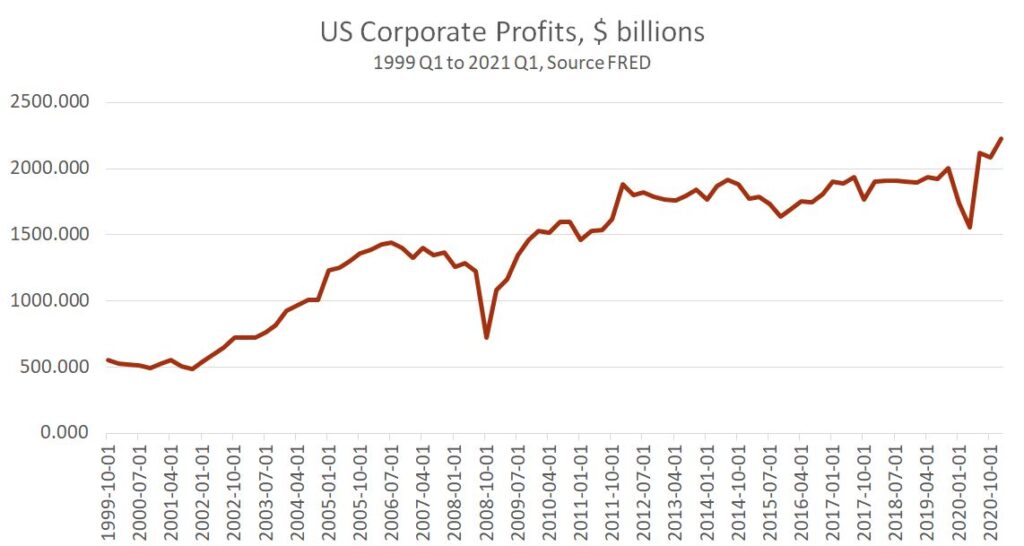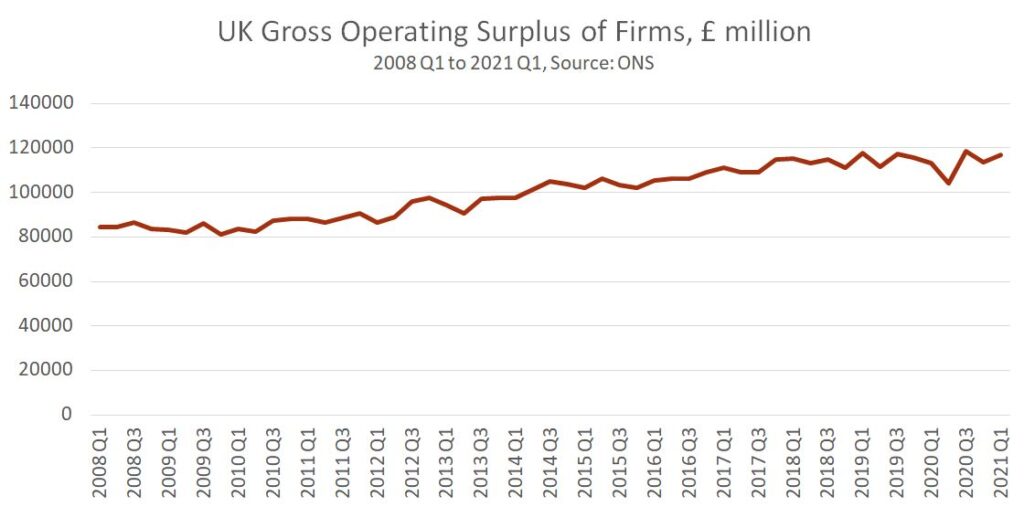By Tom O’Leary
British government policy is widely criticised as being driven by the needs of the economy rather than the requirements of public health. This criticism and the anger it reflects is wholly justified. Yet is difficult to understand since it has produced both an economic disaster as well a public health catastrophe.
And Britain is not alone. Similar outcomes have been recorded in terms of the decline in output and in terms of death toll across Western Europe and in North America, although Britain lies at the extreme end of both.
If we leave aside the issue of incompetence, which has undoubtedly been a factor, it is not reasonable to assume that the richest countries in the world (with some of the most advanced medical and scientific expertise at their disposal) could all randomly come to the broadly to the same disastrous consequences.
Instead, a proper understanding of the real economic objectives of policy in the pandemic shows that, within that framework, policy has been a major success and there has been no disaster at all. Policy is clearly not driven by the need to save lives or protect health. It is also not driven by the needs of ‘the economy’, if what is meant is preserving jobs, maintaining living standards and reviving economic output.
In reality, it is the drive to maintain and expand profits, which is the motor force of capitalist system. This has been rather successful in many of the economies worst afflicted in terms of per capita death toll.
The millions of jobs lost, huge wage cuts, rise in precarious employment and outright bankruptcy of many firms naturally cause huge economic and social dislocation, alongside the death toll. But, since all these can contribute to rising profitability, the policymakers do not seem them as disastrous at all. At most they are seen as an unfortunate by-product, or present a political difficulty for governing parties (but even here, generally speaking, those governments pursuing this line have been supported by other parties). In terms of the central objective of restoring profitability, the elements of economic dislocation listed above are a feature of the plan, and each can make their own contribution.
The trade-off has never been between lives and ‘the economy’. It has always been a trade-off between lives and the opportunity to boost profits. Within the political space allowed, Western governments have overwhelmingly chosen to prioritise profits.
A short note on profits
There is frequently some scepticism about the idea that profitability can rise as output falls, and vice versa that profits can fall as output expands. For a full explanation of the relationship readers are encouraged to read Marx’s Capital, especially this section on the Rate of Profit in Volume III. The short note below cannot do justice to that, but hopefully serves to illustrate one key point.
In this example, a manufacturer produces goods which sell for £100 million. But is unhappy with profits of only £5 million or 5%. The rest is spent on fixed and variable costs, maintaining the factory, paying rent, paying workers, paying suppliers, and paying interest and so on. The manufacturer decides to fire some workers and reduce the remainder’s pay. Because of fewer workers he can only produce goods to sell at £90 million. But costs have fallen so far the profit is now £18 million, or 20%. Both the mass of profits and the rate of the profit have risen.
The converse is true. An increase in output may not lead to either a higher mass of profits or a higher rate of profit if they oblige the manufacturer to increase overtime and overtime pay and higher more workers. Output and sales can rise, but both the mass of profits and the rate of profit can fall.
There are many more factors affecting profits, but the issue of the numbers in employment and pay conform to what is currently happening in the advanced industrialised economies; huge pay cuts and jobs losses to restore profits.
The G7 pandemic
The Western G7 countries have had a disastrous pandemic. Their death toll has been far worse than for the world as a whole, as shown in Chart 1 below.
Chart 1. World per capita death toll from Covid-19 and selected G7 countries

In addition, by insisting on only limited restrictions for international travel and bogus quarantine schemes they have managed to seed the rest of the world with the virus and it mutations. On top of all that, the G7 countries led by Britain and Germany are refusing to waive vaccine patents which would allow the global production of far cheaper generic vaccines for poorer countries. Their aim instead is to ensure huge profits for Big Pharma.
Japan is the only exception in terms of death toll. But because Asian countries in general had to deal with SARS outbreak in 2002 to 2003, they generally have far better outcomes in the pandemic. And Japan has one of the worst outcomes of any country in the Asian Pacific, despite being its richest country.
Chart 2 below shows that this outsized death toll has not ‘protected the economy’ at all. No G7 economy had recovered its pre-pandemic level of GDP by the 1st quarter of 2021, having generally experienced their worst recessions of the modern era. The outcome for the UK economy was the worst of all, still 8.8% below its pre-pandemic level.
Chart 2. G7 Change in Real and Nominal GDP since pandemic

Many international institutions such as the IMF, World Bank and others have been projecting a sharp rebound in output for some time. But we shall see soon whether the recent upsurge in new cases once again forces a postponement of the projected recovery.
Even with these still rosy forecasts for G7 growth, GDP is expected to expand very weakly compared to the world economy as a whole. According to the IMF World Economic Outlook for April this year, over the 3 years 2020 to 2022 cumulative real GDP growth in the G7 will be 3.75%. This compares to the projection for the emerging economies of 9.6% over the same period, which is mainly accounted for by China’s 17.1% projected growth.
As noted above, there has been a dramatic cut in jobs and pay. Across the G7 pay has been cut in real terms and in Japan pay has even been cut sharply in nominal terms. Compared to pre-pandemic levels the combined number of people unemployed has risen by 4.8 million, according to OECD data.
Profits up
The cut in jobs and pay have helped to boost profits, as they are designed to do. Chart 3 below shows the level or mass of profits for the US economy in nominal terms.
Chart 3. US Corporate profits, $ billions

The fall in US profits that began in mid-2006 was the harbinger and cause of the global financial crisis and subsequent Long Recession of 2008 onwards, but the recovery in profits was much slower than the initial recovery from the pandemic slump. It took 3½ years for profits to recover by the end of 2009. This time around they have already hit a new peak and soared past the previous peak in 2009 after just 7 quarters. This profit’s rebound has been faster and stronger than in the previous recession, and by a big margin.
Most G7 economies do not produce data in the same timely way as the US. But UK data is available for a comparable measure of the Gross Operating Surplus up to the 1st quarter of this year. This is shown in Chart 4 below.
Chart 4. The Gross Operating Surplus if UK firms, £mn

The trend is nothing like as dramatic or as clear-cut as in the US, and profits are only marginally above their level at the end of 2019. Even so, it provides a clear indication that the health of the economy, or general well-being are not the determinants of profitability. Profits can be affected by the relationship between capital and labour, and in this pandemic they clearly are. In effect, capital is using the pandemic to alter the relationship of forces in its favour and to the detriment of workers and the poor. They have met with some success to date.
However, it would be premature or even foolish to declare victory for capital. Some of the rise in recorded profits is likely to subsidies, open or disguised from the Western governments. More fundamentally this is a struggle, a struggle between classes.
We have already seen too global stock markets wobble because speculators are concerned about the effect of the resurgent virus on profits, especially the Delta variant. The emergence of as yet unknown variants could have the same effect.
Furthermore, just because capital is dominant in this struggle now, it does not necessarily mean that the outcome is determined. The renewed surge in cases may require further, off-setting attacks on wages, jobs, and conditions to maintain the rise in profits. There may come a point when the attacks will not be endured by workers and the poor.
The past cannot be undone. The G7 countries have let more than a million of their own citizens die and are refusing to help the populations of the Global South with vaccine access, condemning millions more to certain death.
Instead, they have ‘let no good crisis go to waste’, and enacted pandemic-austerity for workers and the poor (the exception being the US), plus vast transfers to big business. Pay cuts for workers and job losses have taken place across the board (led by the US). Tax rises and welfare cuts are in the pipeline, along with privatisations.
At a certain point, the big battalions of the labour movement will need to act if this carnage is to be stopped at any time.

Recent Comments